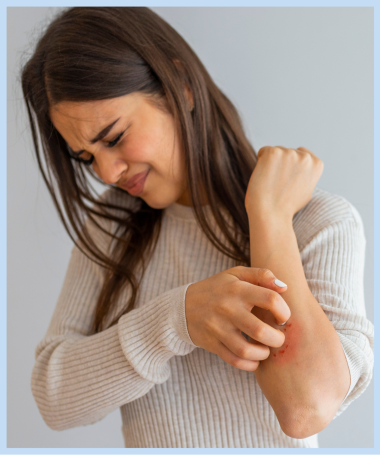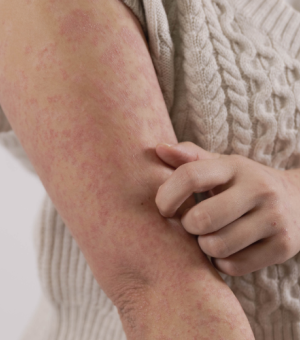Saturday, August 20, 2022
Knowing the Difference Between Eczema and Psoriasis
Dr. Marc-André Doré

Dr Marc-André Doré

Tuesday, September 17, 2024
Psoriasis is a chronic skin condition affecting millions of people worldwide. It is characterized by red, scaly patches and itching, significantly impacting the quality of life for those affected. Although the exact cause is not yet fully understood, it is known to be linked to a dysfunction of the immune system that leads to rapid overproduction of skin cells.
If you think you might be developing psoriasis, it is important to consult your doctor and seek the opinion of a dermatologist. Let’s explore how this condition develops.
Psoriasis is an autoimmune disorder, meaning it occurs when the immune system mistakenly attacks the body's tissues. In this case, the attack is directed at the skin. Normally, skin cells are produced and replaced every 28 to 30 days. However, in people with psoriasis, this process accelerates, causing skin cells to multiply every 3 to 4 days. This rapid turnover results in an accumulation of dead cells on the skin's surface, creating the red, scaly plaques.
The progression of the disease is influenced by a combination of genetic and environmental factors. People with a family history of psoriasis are more likely to develop the condition, indicating a genetic predisposition. However, not all individuals with a genetic predisposition will develop the disease, suggesting that environmental triggers also play a crucial role.

Bacterial or viral infections, especially streptococcal infections, can trigger psoriasis in some people.
High levels of stress can weaken the immune system, potentially triggering the onset or exacerbating existing symptoms.
Cuts, scrapes, or other skin injuries can lead to the appearance of psoriatic lesions, known as the Koebner phenomenon.
Certain medications, such as beta-blockers, lithium, and antimalarials, have been associated with the onset or worsening of symptoms.
A cold, dry climate can also dry out the skin and worsen symptoms.
Psoriasis can present in different forms, each with its own range of symptoms. However, regardless of the type, it generally progresses through three stages: mild, moderate, and severe.
At this stage, the disease may appear as small red, scaly patches, usually covering less than 3% of the body. These patches, also known as psoriatic plaques, are typically found on the elbows, knees, scalp, or lower back. The plaques may be slightly elevated and covered with a whitish buildup of dead cells. Itching and discomfort are common but not severe.
At this stage, it can be managed with over-the-counter topical treatments such as moisturizers, emollients, and mild corticosteroid creams. These treatments help reduce inflammation and keep the skin hydrated, preventing the plaques from becoming more pronounced.
When psoriasis progresses to the moderate stage, the affected skin areas become more extensive, covering 3% to 10% of the body. The plaques may be thicker, more inflamed, and more widespread, causing significant discomfort. In some cases, the lesions may crack and bleed, leading to additional complications such as secondary infections.
Itching and pain may become more intense at this stage, interfering with daily activities and sleep. Topical treatments may no longer be sufficient to manage the symptoms, and patients may require more potent medications, such as prescription corticosteroids, vitamin D analogues, or phototherapy. Phototherapy involves exposing the skin to ultraviolet light under medical supervision, which can slow down the rapid growth of skin cells and reduce inflammation.
Severe psoriasis is characterized by extensive skin coverage, with plaques covering more than 10% of the body. At this stage, the plaques are often very thick, red, and painful. The skin may be severely cracked, leading to bleeding and an increased risk of infection. Severe psoriasis can also affect the nails, making them thick, pitted, or separated from the nail bed.
In addition to physical symptoms, at this stage, the disease can have a profound impact on mental and emotional well-being. Many people with severe psoriasis experience embarrassment, social isolation, or even depression due to the visible nature of the condition.
Treatment at this stage often involves systemic medications that affect the entire body, rather than just the skin. These medications may include oral or injectable drugs. Biologics, a newer class of medications, target specific parts of the immune system to reduce inflammation and slow disease progression. Because these medications can have significant side effects, they are typically reserved for cases where other treatments have failed.
Although psoriasis is a chronic condition with no curative treatment, many people effectively manage their symptoms through a combination of treatments and lifestyle changes. Early intervention is crucial to prevent the disease from progressing to more severe stages. Regular visits to a dermatologist can help ensure that the condition is well-managed and that treatment plans are adjusted as needed.
In addition to medical treatments, lifestyle changes such as maintaining a healthy diet, managing stress, avoiding smoking and excessive alcohol consumption, and using gentle skincare products can help reduce flare-ups and improve overall skin health.
Conclusion
Understanding the development and progression of psoriasis is crucial for effective management. By recognizing the stages and seeking appropriate treatment early, individuals can improve their quality of life and reduce the impact of symptoms. Although living with this condition can be challenging, ongoing research and advancements in treatment options offer hope for better management and improved outcomes.
Looking to learn more?
Saturday, August 20, 2022
Dr. Marc-André Doré

Monday, August 8, 2022
Dr. Marc-André Doré

Tuesday, February 22, 2022
